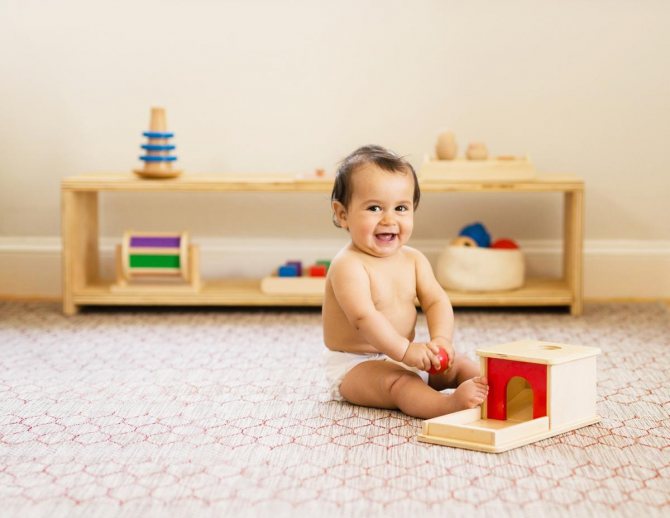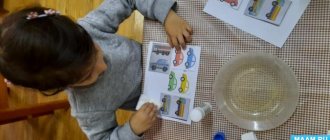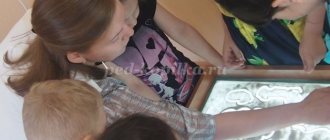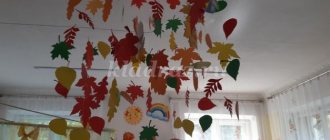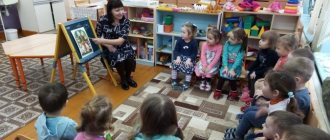Montessori at home for children 1-2 years old
Now let's move on directly to Montessori classes for children of our age category. For convenience, we will divide them into groups, although in reality almost all exercises involve different areas of child development.
Montessori classes for children's sensory development from 1 to 3
This is the largest category that introduces the child to the qualities of objects: colors, shapes, sizes, materials, temperatures, and so on.
- Create boxes with “interesting things”: large hairpins, jars, lids, bottles, dishes, accessories, natural materials. This set is useful for many games: you can simply sort them out in your hands, bury them in the sand, look for pairs, sort them, throw them into a bucket or bowl of water, and so on,
- Buy your first sorter, an insert puzzle, a set of cubes of different sizes, and a pyramid. Present the sets intermittently, regularly putting different selections of games on the shelf,
- Create sensory material with your own hands: take small (side about 10-15 cm) squares of cardboard and, using glue, apply different materials (scraps of fabric, sand, small pebbles, cereals, foil) to one side; sew small bags and fill them with cereals, cotton wool, dry leaves, stones. In games with such material, ask your child to find pairs, make it more difficult by blindfolding the child,
- Consider purchasing musical instruments and sounding materials from a classic Montessori set,
- It would be great to create your own selection of food flavorings and essential oils,
- You can come up with interesting games for your baby using ordinary scraps of fabric: you can look for pairs, see which ones fall faster if you throw them, sort them by color and material,
- Playing with water is a different story: you can heat it up and freeze it, watch the ice melt, tint it, pour it and wipe it, pour it into different containers, and much more.
Montessori development of gross and fine motor skills for children from one year old
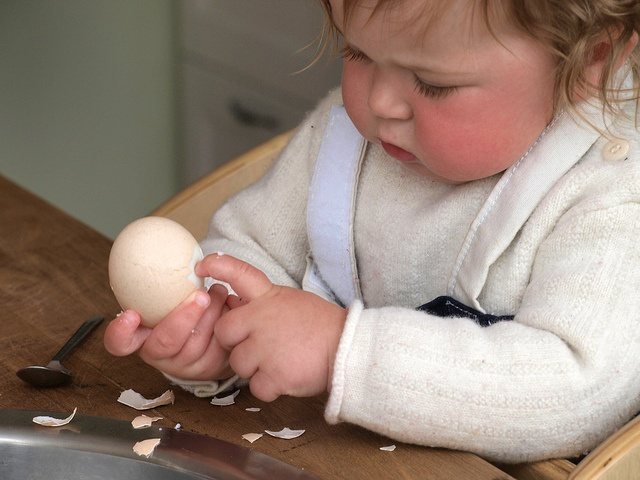
- Many of the activities in the previous section are great for fine motor skills, such as burying objects in the sand, handling objects and sensory cards, playing with water, practicing with Montessori materials,
- To develop gross motor skills, organize the daily routine and environment for the child in a convenient way: let the baby get up and walk around the house as often as possible, climb on chairs and sofas, use a cart or stroller to hone walking skills, be sure to walk in the fresh air, run with the dog and jumps through puddles,
- Rhythmic and gymnastics classes, ball games and even many everyday activities (for example, carrying a full glass of water to the sink) do a lot to develop the baby’s coordination,
- Games with clothespins have proven themselves well among Montessori parents: first, you can put ordinary, loose clothespins in a box and invite the baby to fasten them along the sides, then you can complicate the task by offering to distribute the clothespins by color or start using them for their intended purpose,
- Under supervision, the baby can be asked to study small objects: beans, beads, pebbles, shells,
- Montessori lacing and fastenings work great for children from 1.5 to 2 years old. These sets can be purchased in children's stores and from private craftsmen,
- Pricking dots on the provided paper stencil with a pencil or pen trains the hand and is suitable for children approximately 2 years old.
Provide your baby with freedom of movement and monitor his level of physical activity. Montessori children 1 year and a little older should not sit still for long periods of time. The hands of the little fidget should also be busy: no magic is required, the simplest games with objects are enough.
Montessori speech development exercises for children 1-3 years old
Despite the fact that the baby will really speak a little later, during the Montessori period, teachers emphasize the special importance of the age between 1-2 years for the development of children’s speech.
- Down with pacifiers! Agree, you need a pacifier more to quickly make your child calm down. However, it stops the nonverbal dialogue between the baby and mother and slows down its development. Sometimes it is much more useful to listen to a child’s crying and its reasons than to look for ways to quickly stop it,
- Give your child a reason to expand his vocabulary: books with colorful and realistic pictures (about animals, plants, city and country life), walks to new places, visits. The more the baby sees around him, the more different words and their combinations he hears around him,
- Accompany your actions with explanations: “Now we will pour soup from the pan to Andryusha. This is the ladle we have. You can use a ladle to pour soup into a plate.”
- Encourage baby babble, speak to your baby the words he wants to say: “Ay! Right! Give me some soup, mom!”
- Use material to match pictures and real objects, for example, fruit cards and real fruits
Development of household independence using the Montessori method for children from one year old
Until the age of three, the baby is still strongly attached to his mother and follows her everywhere. Many mothers complain that they are torn between caring for the child and doing household chores and do not even suspect that participation in household chores is one of the best developmental activities for children 1-2 years old, according to Montessori teachers.
In the kitchen:
- give your child a bowl of water and a few vegetables, show them how to wash them,
- Teach your child to peel bananas and other fruits,
- Show how to pour milk into flour, mix everything with a spoon,
- Give your child a cloth so he can clean up after himself,
- Closer to 2 years, show how to cut soft foods (boiled vegetables, bananas),
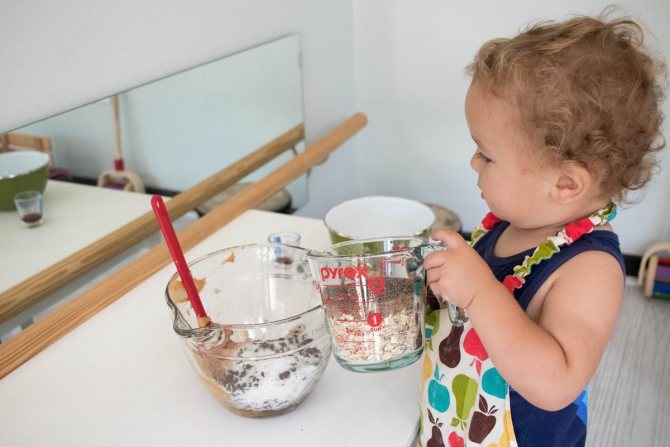
Wash:
- Ask your child to put his things in the washing machine or, conversely, take them out of the machine,
- Give your child time to explore the basket for things, tell him what kind of things he found: “Look, these are mom’s pajamas, and this is dad’s T-shirt, wow, Andryusha found his socks!”
Cleaning:
- Give your baby a small mop, a bucket, a rag, let him help you wipe the dust,
- Let your child wash everything that comes to your mind: dishes, food, toys, rubber slippers, etc.
- Teach your child to water flowers, pour food into a pet’s bowl,
Remember to take time to start and finish any activity: all materials should have their place on the shelves, and the work area should be kept clean. It is at this age that you can teach your baby to keep order on his own.
Montessori creativity classes for children 1-2 years old
- Prepare a comfortable workplace (small chair and table) and a sufficient amount of creative materials (paper, paints, brushes, stencils, natural materials, crayons, pencils, scissors, glue, plasticine)
- Show your child how to use this or that material, look for good ideas (for example, creating stamps from leaves or drawing with ordinary coal from a fire), but do not get carried away with step-by-step instructions, the child should have room for experimentation
“The most important thing is the weather in the house.” Simple truths about education using the Montessori method from one year old.
Sometimes it seems that using the Montessori method at home is very suitable for busy parents, as children quickly become independent. This feeling is deceptive, since at the age of 1 to 3 the baby still spends most of his time with adults and, first of all, the child’s progress depends on their goodwill and interest.
- It is important to talk to your child as often as possible. Children learn their native language from their parents, repeating almost everything after them. Speak in simple phrases, repeat what was said, speak clearly, do not babysit or confuse the baby with non-existent words.
- Follow a daily routine. All Montessori teachers unanimously advise that in raising children from one year onwards special attention should be paid to the schedule, so it is easier for children to grasp the patterns of this world,
- Try to be flexible and prudent. Kids are very worried if they are rushed or forced to do something quickly. Allow time to build up, especially if we are talking about getting ready somewhere,
- Pay attention to your well-being and emotional state - a healthy and calm mother, ready to truly engage in communication, is needed by the child much more than the most fashionable toys and development aids,
- Don’t hesitate to seek support from specialists in the Montessori method: they are always ready to help find fresh ideas for activities, explain the difficulties that arise in raising a baby after 1 year, and sometimes just support the family
At home, the baby should be comfortable and safe, it is important to have cheerful and responsive adults nearby, and life itself should carry as little serious stress and disappointment as possible (and we are not talking about situations where we were not allowed to taste the asphalt or tear off a leaf from a ficus, such stress is an integral part of growing up). Only after providing the baby with the basic minimum can you move on to developmental activities.
Conclusion
Montessori classes from 1 year old are a whole world for children. Here, special toys and ordinary objects, structured tasks and free flight of imagination, joint work with an adult and independent activities of the child can coexist.
In Montessori classes for children 1-2 years old, the most important thing is to maintain a balance of activities: do not force the child to continue if he is tired, help him find new interesting games, chat more with the baby, know how to let him go on his own in time and monitor the child’s physical activity during the day.
"My home is my castle". Montessori recommendations for arranging a home for a baby aged 1-2 years.
Montessori teachers always remind that the environment for the child should be comfortable and safe. It’s not so easy to grow and become independent when you are literally surrounded by insurmountable obstacles everywhere: chairs twice your height, a sink the size of an elephant, a cup that cannot be lifted and a spoon that does not fit into your mouth.
Before planning a Montessori lesson, look around your home and make sure your child has everything he needs:
- Comfortable place to sleep. The child must be able to lie down and get out of bed without adult help,
- Safe movement in the space allocated for the child. Close the sockets with special plugs, remove the wires, make sure that all furniture and decorative elements are securely fastened,
- Comfortable temperature and warm floor. Kids move around the floor a lot, so it’s worth covering it with warm carpets in advance or thinking about heated floors,
- Children's size furniture and tools: low chairs, table, shelves, drawers, ladder for access to the sink, convenient dishes
- An organized and accessible area for Montessori developmental activities. Use baskets, trays and bags for sorting and place the material on low shelves so that the baby can reach interesting items himself.
